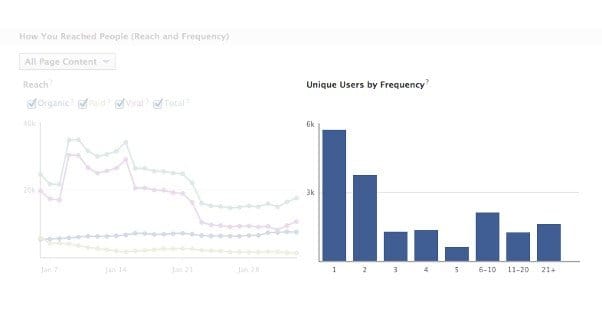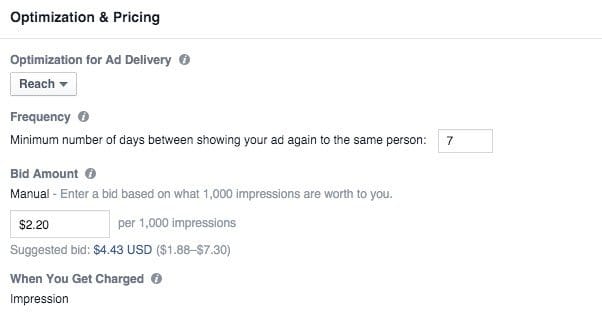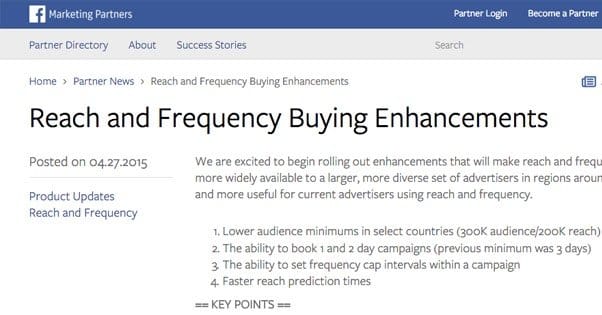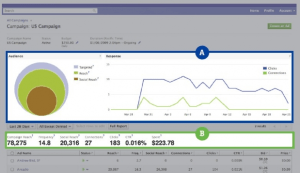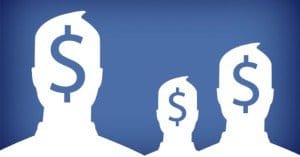 Written by ContentPowered.com
Written by ContentPowered.com
“Reach and Frequency” is an option for setting up Facebook ads, specifically through power editor. While both terms have meaning on their own, together they make a specific feature that we’ll discuss.
What is Reach?
The concept of reach is quite basic, and it’s something every Facebook marketer should know. It’s even a metric that’s shown right there next to every post in Facebook Insights. Put simply, it’s the number of people Facebook has shown your post to.
Now, this isn’t 100% a reading of the number of people who have actually seen your post. How often have you been scrolling through your feed and had it refresh part-way through a page, or clicked to refresh it without reading the posts lower down on the page? You didn’t actually see those posts – or you scrolled past them without paying attention to what they say – but Facebook counts that as reach.
Reach is not to be confused with impressions, either. When you see a post, refresh the page, and see it again, that’s two impressions. If you see a post, then see it again when a friend shares it, and see it again as an ad, that’s three impressions. However, since you’re just one person, you only count for one in reach. This is why reach is generally lower than impressions.
What is Frequency?
Frequency is a number that indicates how often a given person in your target audience has seen your post, typically only measured for ads.
Imagine, for example, that you have a target audience of exactly 1,000 people. You could have 1,000 followers on your page and simply use your followers as the target audience; that would be perfectly plausible.
- A frequency of .5 means that only 500 out of your 1,000 followers has seen that ad.
- A frequency of 1 means that all 1,000 followers have seen the ad exactly once each.
- A frequency of 2 means that all 1,000 followers have seen the ad exactly twice each.
And so on. This often ends up being a two-point decimal number, like 1.29 or 2.87, rather than a nice round number. It’s also an average; when I say that every single person has seen your ad exactly once, I don’t mean that literally. What I mean is that your impressions and reach are equal. One person might not have seen the ad, and another might have seen it twice; those two cancel each other out, for the average frequency of 1.
Frequency is an incredibly important metric. If your frequency is too low, under 1, it means you’re not taking full advantage of your target audience. You need a higher budget to reach all of them, or a tighter set of targeting options to more fully exploit a smaller audience. A low frequency on a high-performing ad is an opportunity to invest more to get more returns.
On the other hand, a high frequency – 3 or more, generally – means banner blindness will kick in. According to Comscore, the average Internet user is exposed to over 1,700 banner ads every month during their web browsing. That’s a lot, and I guarantee you don’t even notice most of them. The brain considers banners and other similar ads to be extraneous, superfluous content. It’s not necessary to what you’re reading, any more than the top bar navigation or corner logo is on a site. You tune them out, the same way you might tune out an annoying hum in the workplace once you get used to it.
A high ad frequency means you’re either paying too much for your ads or you’re running the ad for too long. People are getting used to it and will stop paying attention to it. Some users, upon seeing the same ad too many times, will even click to hide it. This will tank your quality score as well, which is bad because it makes your ads show up less often, and cost more when they appear.
What is Power Editor?
You probably know this by now, so I’ll be brief. Power Editor is a browser extension for Google Chrome designed to change the ad management experience on Facebook. It’s aimed at experienced users who know what they’re doing, but honestly, it makes things so much easier that I recommend it to all but the most novice of novices.
In particular, Power Editor has a few great features over the basic ads manager experience. For one thing, it makes it a lot easier to create ads in bulk, for tweaks and split testing. For another, it often adds features – ad types, targeting options, objectives, and so forth – that are in beta. Facebook uses the smaller Power Editor user base to test and improve new features before they roll out to the ads manager at large. Plus, some features never do; Power Editor ends up being a robust and useful tool with features that will never make it to common use through the native ads manager.
In short: use Power Editor. On top of being excellent in every way, it’s possibly required to use reach and frequency buying. Why just possibly? I haven’t used the ads manager without Power Editor in so long I don’t even know any more, and I really suggest you get with the program as well.
What is Reach and Frequency Buying?
Reach and frequency buying is a feature Facebook rolled out in 2014, specifically announced in early June, as seen in this blog post. The post in question doesn’t say much. In fact, aside from a bit of ad-speak, the few paragraphs they use to announce it are more or less meaningless. They don’t tell you what the feature is, how it will work, or even how to use it.
To learn more details, one route you can take is to dig into the developers API section, found here. I don’t necessarily recommend it, though. When I mean developers API, I really mean it; there’s a lot of code and specific API data that you’ll never need to know unless you’re personally developing some sort of Power Editor equivalent or ads manager.
To put things in plain English, I’ll summarize. The reach and frequency setting is a type of campaign structure that’s designed to optimize cost and delivery. With it, you can:
- Implement a lifetime frequency cap for a campaign, ensuring that no matter how high your budget is, you’ll never exceed a specific frequency, and the campaign will shut down upon reaching that frequency.
- Receive estimates about the reach and budget for the ad campaign that are, according to Facebook themselves, 99% accurate to what will actually happen.
- Cap frequency in order to increase reach across a target audience. In other words, minimize cases where you have one person seeing the ad twice and another person not seeing it, averaging out to a frequency of 1. This helps ensure that a frequency of 1 is actually the users all seeing the ad once.
- View estimates by changing the desired budget as normal, or by setting a reach goal and seeing how much budget you need to reach that amount of exposure.
In addition, this comes with a graphical progress bar that shows how much of your potential audience you have reached, as a percentage.
What this all boils down to, aside from a few minor display features, is one simple thing. By capping frequency, you extend reach. This makes your budget work smarter, to show your ad to more people a more reasonable amount of time, rather than showing it to a clustered few.
Why doesn’t Facebook do this by default? Well, they kind of do. The problem is, frequency being an average means that Facebook has a hard time accurately controlling reach, impressions, and exposure. They also don’t have an easy way of knowing what frequency you consider ideal. While you might prefer a frequency of 2, they figure that 3 is fine, so they let your ads reach certain people more than you would prefer.
Since the initial roll-out in 2014, Facebook has made some changes, including upgrading the feature from beta-only to full use.
Reach and Frequency Beta Specifications
There are some specifications that go along with this type of campaign. Some of the original specifications have been changed, which I’ll go over in a minute.
- Reach and frequency buying campaigns are only available with CPM pricing. This is fine, because oCPM is one of the best ways to spend through Facebook for certain objectives, and it was removed from other objectives entirely.
- There are time constraints on reach and frequency campaigns. They cannot bet set for anything under 72 hours, or anything longer than 30 days.
- Once a reach and frequency campaign is set in motion, it cannot be paused and it cannot have its goal changed. It can be deleted entirely, though; you’re not 100% locked in to spending the money for it if an emergency arises. You are still charged for the impressions you get, however, and if you cancel and delete your campaigns too often, Facebook will revoke access to the tool.
- Initially only available for page posts and domain ads, not other ad types or positions.
- You are limited to running only a single ad unit – not ad set, not ad campaign – within this campaign type. That means you need to do your split testing elsewhere, and only use tried and tested ads here.
- You can only target your own fans. You cannot target friends of fans, and you cannot target audiences that exclude your fans. Most standard targeting options are available, but you cannot use website custom audiences. You are also limited to targeting only one country at a time.
- Running other campaigns with the same targeting options, from the same Facebook page, will interfere with the reach and frequency measurements and can harm the effectiveness of the ads.
Reach and Frequency Buying Enhancements in 2015
In early 2015, Facebook made an update to reach and frequency buying to improve the system for pretty much everyone using it.
These are the improvements they made:
- One common problem with reach and frequency buying was that people in smaller, less-populous countries would not be able to use it due to the mandatory minimum audience requirements. The minimum audience was dropped from 1 million people to 300,000 people for all countries except the UK, France, Germany, Italy, Turkey, Egypt, India, Indonesia, Philippines, Thailand, Vietnam, Argentina, Brazil, Mexico, and the USA. Those listed countries still require minimum audiences of 1,000,000 people.
- Additionally, with those smaller mandatory audiences, you are required to set a budget sufficient to reach at least 200,000 of those people.
- The initial limitation of minimum 3 days was removed; reach and frequency campaigns can now run for one or two days only.
- You are able to set sub-caps for frequency in lengthier campaigns. For example, if you were running a 30-day campaign, you can set a frequency cap of 2 per each 10-day period. This means that a user might see your ad six times over the course of that month, they will never see it more than twice in a 10-day period.
While the first one doesn’t affect most of the people reading this blog post, it was very useful for some marketers. The same can be said of reach and frequency as a whole, though, because it is not without its flaws.
The Flaws and Caveats of Reach and Frequency Buying
The first major problem with reach and frequency buying is the two-fold combination of the mandatory minimum audience and the equally-mandatory minimum spend. In the USA, you are required to choose an audience of 1,000,000 people minimum with your targeting. It can be as large as you like, but it cannot be smaller than that. This means you have a mandatory minimum budget requirement that, even at oCPM costs, will range in the thousands to tens of thousands of dollars if not higher. It’s firmly a tool made for mid-size and large advertisers, not small businesses with weekly spend on the order of hundreds, not thousands.
Another issue is how the Facebook frequency capping works. For one thing, a frequency cap of 2 is not actually a cap of 2. It’s actually a cap of 2.99, or “anything less than 3.” You might end up with an actual frequency of 2.68 when you cap it at 2, and there’s nothing you can do about it but reduce the cap to 1 on your next attempt. This can be a costly mistake when you’re paying for the impressions.
Finally, Facebook tries to promote reach and frequency buying as the only real way to control your reach and frequency, but it’s not. You have other tools, either through third party services or through careful management and monitoring of your campaigns, to achieve the goals set forth in your campaign. Plus, without the lock-in of reach and frequency buying, you have more flexibility to test and tweak your ad campaigns.
At the end of the day, reach and frequency buying is a pretty useful tool if you have the budget for it, but it’s not perfect. It’s a shortcut to managing ads you know will work; just set it, fire it off, and forget about it. It’s a niche use, though, and not something you should try to implement all the time.

